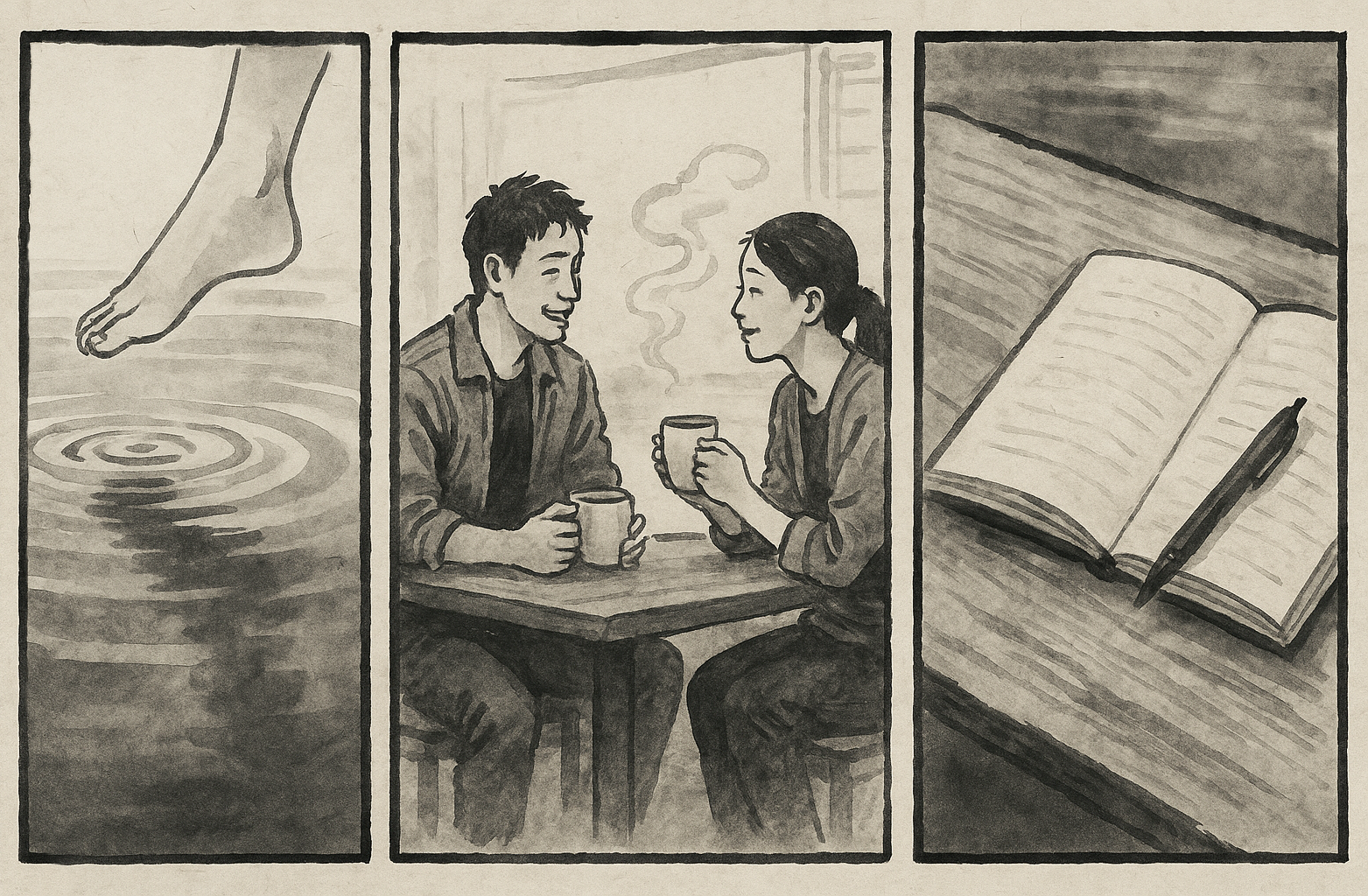Float, Connect, Reflect
Floating has a wonderful habit of surprising us. One session might feel like drifting into a nap where time collapses, the next like a full-body massage. Some floats erupt in vibrant visuals, others drop you straight into a contemplative stillness that lingers for days. In fact, a float session rarely gives us exactly what we expect, although it often provides exactly what we need. What happens inside the tank is only half the story, though. The other half unfolds afterwards, when you weave those salt-soaked experiences into the fabric of everyday life. Talking (or even jotting down a few quick notes) about your float is one of the simplest ways to pull those mental and physical benefits into the flow of everyday living.
Post-float integration is more than swapping stories for entertainment’s sake. Sharing an experience reinforces memory pathways and helps the brain tag the event as meaningful, which in turn amplifies its benefits. Neuroscientists sometimes refer to this as “elaborative rehearsal,” and studies on expressive writing and social disclosure show that it boosts mood, sharpens insight, and even nudges immune markers in a more healthy direction. In plainer terms: talking about your float can reinforce, and sometimes even deepen, the therapeutic effects you felt in the tank.
One of the easiest ways to spark that conversation is to schedule a float at the same time as a friend. You don’t have to climb into pods at the exact same minute, but blocking out the same afternoon and meeting for tea afterwards creates a natural debrief ritual. Because you’ve both been wrapped in silence, the simple act of describing sensations can feel fresh and almost luxurious. You’ll notice how quickly the brain lights up when it hears a detail that mirrors your own experience: “Wait, you felt tingles in your hands too?” That shared recognition triggers a dose of social oxytocin, strengthening recall and deepening the sense that what happened in the tank matters.
If sharing a personal float experience sounds intimidating, or you don’t know where to start, here are a few gentle prompts that you can build off of. “What surprised you about your float?” Surprise can be likened to memory’s highlighter pen, so reviewing the surprising moments of your session is a great place to start. “Where did your mind wander to?” The answer often reveals those things that are on your mind, even if they’re normally below your conscious attention.
“How do you feel, right now?” is a favorite of float regulars and helps to root the conversation in the present moment. Noticing changes in body tension or mood lends itself to practical observation, rather than drifting immediately into the abstract. Keep in mind that no one is grading your insights – it’s okay to just say, “I don’t know” or, “I’m not exactly sure” and to just move on. It’s also good to remember that listening matters as much as talking when you’re sharing your float experiences with someone else. This blog isn’t titled “How to have a good, reasonable conversation with other humans,” so we won’t go into too much detail, but it’s always good to keep the balance of the conversation in mind when you’re sharing what may be fairly personal experiences.
And, of course, not everyone feels comfortable sharing their float experiences right away, and some floats are so delicate they need solitude to blossom. Journaling by yourself can also be a great way to review your float, and can have many of the same benefits. Translating sensation into any kind of language harnesses the love that our brain has for words. Even scribbling half-sentences or voice-to-text fragments solidifies those fleeting, dream-like moments. You may never reread the entry, yet the very act of writing nudges the experience from ephemeral to solid.
Pen and paper certainly have a tactile charm, but there’s also no shame in tapping out a post-float note in your phone before the outside world floods back in. Some floaters even hit the record button and speak stream-of-consciousness into a voice memo while it’s still fresh. Choose whatever medium feels most comfortable and lets you capture impressions while they’re still warm.
There are many studies out there exploring the science that supports these practices. James Pennebaker’s famous expressive-writing experiments, starting back in the 80s, showed that 15 minutes of uninhibited journaling, four days in a row, correlated with lower doctor visits and improved mood months later. Positive-event sharing studies at UCLA found that recounting a good experience with an engaged listener boosted happiness more than the event alone. Meanwhile, neuro-imaging on seasoned meditators suggests that post-practice reflection helps stabilize default-mode-network shifts. In general, these experiments emphasize that even a few minutes of storytelling or scribbling often extend the therapeutic benefits of a float.
These and similar studies also point to a simple truth: integration needs breathing room. Resist the reflex to refresh your notifications the moment you towel off. Gift yourself at least ten phone‑free, computer-free minutes to let the stillness settle. Choose a ‘landing pad’ – a lounge chair, a quiet café corner, or the front seat of your car with the engine off – and anchor the silence with something simple like a mug of herbal tea, a slow neck roll, or some unhurried breaths. If you scheduled a float alongside a friend, but crave solo space first, agree to meet up in half an hour so neither of you feels hurried.
When you do settle in to talk or journal about your experience, you may find that you're not sure where to start. Just be honest with yourself, and with others. Even if you can’t remember much at all, for example, it's fine to just acknowledge the fact of that blankness. If a tide of emotion surfaced, you can share that if it feels comfortable, or simply mention it and say that you don't feel like going into more detail right now. And if you were initially looking forward to talking about the experience but now you just aren't feeling like it, you can just tell your friend exactly that, and they'll understand. Reflection doesn’t have to be immediately verbal, and the goal is integration, not performance.
The result of these small rituals is a subtle but powerful feedback loop. Each time you reflect, the brain files these reflections under “experiences worth keeping,” which makes the next session feel richer, which in turn gives you more to reflect upon. Over weeks or months, patterns tend to emerge. Perhaps the same insight returns in different forms, or you notice a gradual lightness in your shoulders that lingers between appointments. That’s the quiet payoff of spending time processing your experiences: transformation that sticks around more in the long term.
So, the next time you slide the lid open and step out, remember that the story isn’t finished when you leave your float room. Take a moment – or ten – to reflect. Consider inviting a friend along ahead of time to compare notes with after, or bring a pocket-sized notebook and free-write in parked-car silence. Whatever you decide, taking a little time to linger in that post-float glow, to ponder and perhaps chronicle parts of your experience, only helps to integrate it into your regular life.

